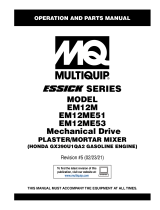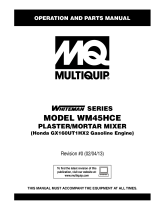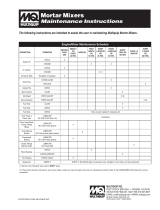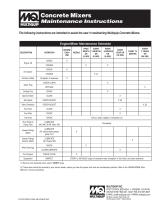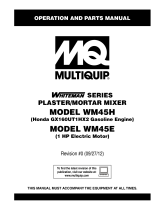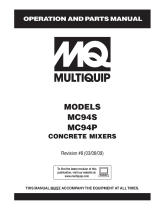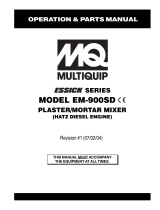Page is loading ...

OPERATION MANUAL
THIS MANUAL MUST ACCOMPANY THE EQUIPMENT AT ALL TIMES.
MODELS
EM90SH8/EM90PH8
EM90SHE/EM90PE
PLASTER AND MORTAR MIXERS
(HONDA GX240 GASOLINE ENGINE
AND 3 HP ELECTRIC MOTOR)
Revision #3 (10/30/19)
SERIES
To find the latest revision of this publication or
associated parts manual, visit our website at:
www.multiquip.com

PAGE 2 — EM90 SERIES PLASTER/MORTAR MIXERS • OPERATION MANUAL — REV. #3 (10/30/19)
PROPOSITION 65 WARNING

EM90 SERIES PLASTER/MORTAR MIXERS • OPERATION MANUAL — REV. #3 (10/30/19) — PAGE 3
Grinding/cutting/drilling of masonry, concrete, metal and
other materials with silica in their composition may give
off dust or mists containing crystalline silica. Silica is a
basic component of sand, quartz, brick clay, granite and
numerous other minerals and rocks. Repeated and/or
substantial inhalation of airborne crystalline silica can
cause serious or fatal respiratory diseases, including
silicosis.In addition, California and some other
authorities have listed respirable crystalline silica as a
substance known to cause cancer. When cutting such
materials, always follow the respiratory precautions
mentioned above.
WARNING
Grinding/cutting/drilling of masonry, concrete, metal and
other materials can generate dust, mists and fumes
containing chemicals known to cause serious or fatal
injury or illness, such as respiratory disease, cancer,
birth defects or other reproductive harm. If you are
unfamiliar with the risks associated with the particular
process and/or material being cut or the composition of
the tool being used, review the material safety data
sheet and/or consult your employer, the material
manufacturer/supplier, governmental agencies such as
OSHA and NIOSH and other sources on hazardous
materials. California and some other authorities, for
instance, have published lists of substances known to
cause cancer, reproductive toxicity,or other harmful
effects.
Control dust, mist and fumes at the source where
possible. In this regard use good work practices and
follow the recommendations of the manufacturers or
suppliers, OSHA/NIOSH, and occupational and trade
associations.Water should be used for dust
suppression when wet cutting is feasible. When the
hazards from inhalation of dust, mists and fumes cannot
be eliminated, the operator and any bystanders should
always wear a respirator approved by NIOSH/MSHA for
the materials being used.
WARNING
SILICOSIS WARNING RESPIRATORY HAZARDS
SILICOSIS/RESPIRATORY WARNINGS

PAGE 4 — EM90 SERIES PLASTER/MORTAR MIXERS • OPERATION MANUAL — REV. #3 (10/30/19)
TABLE OF CONTENTS
EM90 Series
Plaster and Mortar Mixers
Proposition 65 Warning ........................................... 2
Silicosis/Respiratory Warnings ................................ 3
Table of Contents ..................................................... 4
Training Checklist .................................................... 5
Nameplate and Safety Decals ................................. 6
Safety Information ............................................. 7–12
Towing Guidelines ........................................... 13–14
Safety Chain Connection ....................................... 15
Specifications (Mixer) ............................................ 16
Specifications (Engine/Motor) ................................ 17
General Information ............................................... 18
Components (Mixer) ........................................ 20–21
Components (Engine) ............................................ 22
Electric Motor ........................................................ 23
Inspection ........................................................ 24–26
Operation ......................................................... 27–31
Maintenance (Engine) ..................................... 32–34
Maintenance (Mixer) ........................................ 35–39
Troubleshooting (Mixer) ......................................... 40
Troubleshooting (Electric Motor) ............................ 41
Troubleshooting (Engine) ................................. 42–43

EM90 SERIES PLASTER/MORTAR MIXERS • OPERATION MANUAL — REV. #3 (10/30/19) — PAGE 5
TRAINING CHECKLIST
Training Checklist
No, Description OK? Date
1
Read operation manual
completely.
2
Machine layout, location of
components, checking of engine
oil levels.
3 Fuel system, refueling procedure.
4
Operation of controls (machine
not running).
5
Safety controls, safety stop switch
operation.
6 Emergency stop procedures.
7 Machine transport and storage.

PAGE 6 — EM90 SERIES PLASTER/MORTAR MIXERS • OPERATION MANUAL — REV. #3 (10/30/19)
NAMEPLATE AND SAFETY DECALS
The EM-90 plaster and mortar mixer is equipped with a number of safety decals. These decals are provided for operator
safety and maintenance information. Figure 1 below illustrates these decals as they appear on the machine. Should any
of these decals become unreadable, replacements can be obtained from your dealer or the MQ Parts Department.
Figure 1. Nameplate and Safety Decals
SAFETY
INSTRUCTIONS
1. Read owner’s manual
before operating.
2. Keep unauthorized and untrained
people away from machine during
operation.
3. Make sure all safety devices are in
place before this machine is started.
4. Make sure engine is turned off and
spark plug wire is disconnected before
cleaning the machine.
5. Keep hands and ngers away from
moving objects.
6. Do not operate machine in an enclosed
area, proper ventilation is required.
7. Never leave machine unattended when
operating.
8. Always stop engine and allow engine
to cool before adding fuel or oil.
520935
P/N 521232
CAUTION
1. Use manufacturer’s recommended torque values
when tightening wheel lug nuts.
2. Use manufacturer’s recommended tire pressure
values when inating tires. DO NOT exceed
recommended tire pressure.
INSPECT BEFORE TOWING
TIGHTNESS OF WHEEL NUTS
TIRE PRESSURE
Keep safety grate, guards and doors
in place. Shut off engine or electric
motor before inspection or maintenance.
Moving parts can cut and crush.
engine or electric motor
before placing hands in mixing drum.
SHUT OFF
This machine to be operated by qualied
personnel only. Ask for training as needed.
P/N 521229
WARNING
To avoid injury, you read and
understand operator’s manual before
using this machine.
MUST
P/N 521231
CAUTION
LEGEND
REPRESENTS LOCK PIN
REPRESENTS DRUM STOP BLOCK
MIX
TOW
DRUM LOCK POSITIONING
SEE OPERATION MANUAL FOR PROPER
DRUM LOCK POSITIONING
P/N 521232
CAUTION
1. Use manufacturer’s recommended torque values
when tightening wheel lug nuts.
2. Use manufacturer’s recommended tire pressure
values when inating tires. DO NOT exceed
recommended tire pressure.
INSPECT BEFORE TOWING
TIGHTNESS OF WHEEL NUTS
TIRE PRESSURE
Keep safety grate, guards and doors
in place. Shut off engine or electric
motor before inspection or maintenance.
Moving parts can cut and crush.
engine or electric motor
before placing hands in mixing drum.
SHUT OFF
This machine to be operated by qualied
personnel only. Ask for training as needed.
P/N 521229
WARNING
To avoid injury, you read and
understand operator’s manual before
using this machine.
MUST
CABINET
REAR VIEW
MODEL
SERIALNO.

EM90 SERIES PLASTER/MORTAR MIXERS • OPERATION MANUAL — REV. #3 (10/30/19) — PAGE 7
SAFETY INFORMATION
Do not operate or service the equipment before reading
the entire manual. Safety precautions should be followed
at all times when operating this equipment.
Failure to read and understand the safety
messages and operating instructions could
result in injury to yourself and others.
SAFETY MESSAGES
The four safety messages shown below will inform you
about potential hazards that could injure you or others. The
safety messages specifi cally address the level of exposure
to the operator and are preceded by one of four words:
DANGER, WARNING, CAUTION
or NOTICE.
SAFETY SYMBOLS
DANGER
Indicates a hazardous situation which, if not avoided,
WILL result in DEATH or SERIOUS INJURY.
WARNING
Indicates a hazardous situation which, if not avoided,
COULD result in DEATH or SERIOUS INJURY.
CAUTION
Indicates a hazardous situation which, if not avoided,
COULD result in MINOR or MODERATE INJURY.
NOTICE
Addresses practices not related to personal injury.
Potential hazards associated with the operation of this
equipment will be referenced with hazard symbols which
may appear throughout this manual in conjunction with
safety messages.
Lethal exhaust gas hazards
Explosive fuel hazards
Burn hazards
Rotating parts hazards
Symbol Safety Hazard

PAGE 8 — EM90 SERIES PLASTER/MORTAR MIXERS • OPERATION MANUAL — REV. #3 (10/30/19)
SAFETY INFORMATION
GENERAL SAFETY
CAUTION
NEVER operate this equipment without proper protective
clothing, shatterproof glasses, respiratory protection,
hearing protection, steel-toed boots and other protective
devices required by the job or city and state regulations.
Avoid wearing jewelry or loose-fi tting clothes that may
snag on the controls or moving parts as this can cause
serious injury.
NEVER operate this equipment when not
feeling well due to fatigue, illness or when
on medication.
NEVER operate this equipment under the
infl uence of drugs or alcohol.
ALWAYS clear the work area of any debris, tools, etc.
that would constitute a hazard while the equipment is
in operation.
ALWAYS check the equipment for loosened threads or
bolts before starting.
DO NOT use the equipment for any purpose other than
its intended purposes or applications.
NOTICE
This equipment should only be operated by trained and
qualifi ed personnel 18 years of age or older.
Whenever necessary, replace nameplate, operation and
safety decals when they become diffi cult to read.
Manufacturer does not assume responsibility for any
accident due to equipment modifi cations. Unauthorized
equipment modifi cation will void all warranties.
NEVER
use accessories or attachments that are not
recommended by Multiquip for this equipment. Damage
to the equipment and/or injury to the user may result.
ALWAYS know the location of the nearest
fi re extinguisher.
ALWAYS know the location of the nearest
fi rst aid kit.
ALWAYS know the location of the nearest phone or
keep
a phone on the job site.
Also, know the phone numbers
of the nearest ambulance, doctor and
fi re department.
This information will be invaluable in the case of an
emergency.
MIXER SAFETY
DANGER
NEVER operate the equipment in an
explosive atmosphere or near combustible
materials. An explosion or fi re could result
causing severe bodily harm or even death.
DO NOT mix fl ammable or explosive substances.

EM90 SERIES PLASTER/MORTAR MIXERS • OPERATION MANUAL — REV. #3 (10/30/19) — PAGE 9
SAFETY INFORMATION
WARNING
NEVER place your hands inside the drum
while starting or operating this equipment.
NEVER disconnect any emergency
or safety devices. These devices are
intended for operator safety. Disconnection of these
devices can cause severe injury, bodily harm or even
death. Disconnection of any of these devices will void
all warranties.
Before operating the mixer, ensure that the safety grate
is in position and correctly fi tted.
CAUTION
NEVER lubricate components or attempt service on a
running machine.
NOTICE
ALWAYS keep the machine in proper running condition.
ALWAYS ensure the mixer is on level ground before mixing.
Fix damage to the machine and replace any broken
parts immediately.
ALWAYS store equipment properly when it is not being
used. Equipment should be stored in a clean, dry location
out of the reach of children and unauthorized personnel.
ALWAYS make sure the mixer is clean of dried materials.
DO NOT allow material to build up inside the drum. Keep
the drum, frame and wheels clean. Excess debris can
fall off on the highway and/or build up on the frame and
wheels, creating an unbalanced condition leading to
premature metal fatigue.
ENGINE SAFETY (GASOLINE MODELS ONLY)
DANGER
Engine fuel exhaust gases contain poisonous carbon
monoxide. This gas is colorless and odorless, and can
cause death if inhaled.
The engine of this equipment requires an adequate
free fl ow of cooling air. NEVER
operate this equipment
in any enclosed or narrow
area where the free flow
of air is restricted. If the air
fl ow is restricted it will cause
injury to people and property
and serious damage to the
equipment or engine.
WARNING
DO NOT
place hands or fingers inside the engine
compartment when the engine is running.
NEVER
operate the engine with heat shields or
guards removed.
Keep fi ngers, hands, hair and clothing away
from all moving parts to prevent injury.
DO NOT remove the engine oil drain plug
while the engine is hot. Hot oil will gush out of the oil
tank and severely scald any persons in the general area
of the mixer.
CAUTION
NEVER touch the hot exhaust manifold,
muffl er or cylinder. Allow these parts to cool
before servicing the equipment.
Make certain the operator knows how to and is capable
of turning the engine OFF in case of an emergency.
NOTICE
NEVER
run the engine without an air fi lter or with a dirty
air fi lter. Severe engine damage may occur. Service the
air fi lter frequently to prevent engine malfunction.
NEVER tamper with the factory settings
of the engine or engine governor. Damage
to the engine or equipment can result
if operating in speed ranges above the
maximum allowable.
DANGEROUS
GAS FUMES

PAGE 10 — EM90 SERIES PLASTER/MORTAR MIXERS • OPERATION MANUAL — REV. #3 (10/30/19)
SAFETY INFORMATION
FUEL SAFETY (GASOLINE MODELS ONLY)
DANGER
DO NOT start the engine near spilled fuel or combustible
fl uids. Fuel is extremely fl ammable and its vapors can
cause an explosion if ignited.
ALWAYS refuel in a well-ventilated area, away from
sparks and open fl ames.
ALWAYS use extreme caution when working with
fl ammable liquids.
DO NOT fi ll the fuel tank while the engine is running
or hot.
DO NOT overfi ll the tank, since spilled fuel can ignite if it
comes into contact with hot engine parts or sparks from
the ignition system.
Store fuel in appropriate containers, in well-ventilated
areas and away from sparks and fl ames.
NEVER use fuel as a cleaning agent.
DO NOT smoke around or near the
equipment. Fire or explosion could result
from fuel vapors or if fuel is spilled on a
hot engine.
GENERATOR SAFETY
If using a generator to power the mixer, refer
to the applicable generator manual safety
information section.
ELECTRIC MOTOR SAFETY
(ELECTRIC MODELS ONLY)
NOTICE
Operate the electric motor only at the specifi ed voltage
indicated on the nameplate.
NEVER spray water onto the electric motor.
ALWAYS disconnect the AC power plug from the power
source before moving the mixer.
ALWAYS make sure the ON/OFF switch
on the electric motor is in the OFF position
when not in use and before inserting the
mixer’s power plug into an AC receptacle.
Power Cord/Cable Safety
DANGER
NEVER let power cords or cables lay in water.
NEVER use damaged or worn
cables or cords when
connecting the equipment to a generator. Inspect the
insulation for cuts.
NEVER grab or touch a live power
cord or cable with wet hands. The
possibility exists of electrical shock,
electrocution or death.
Make sure power cables are securely connected.
Incorrect connections may cause electrical shock and
damage to the mixer.
CAUTION
Ensure that cables and cords will not be tripped over or
trapped underneath the mixer.
NOTICE
ALWAYS
make certain that the proper power or
extension cord has been selected for the job.
TRANSPORTING SAFETY
CAUTION
NEVER
allow any person or animal to stand underneath
the equipment while lifting.
NOTICE
ALWAYS
make sure forklift forks are inserted as far as
possible into the pockets (if applicable) when lifting the mixer.
ALWAYS shut down the engine before transporting.
NEVER lift the equipment while the engine is running.
Tighten the fuel tank cap securely and close the fuel
cock to prevent fuel from spilling.
DO NOT lift the machine to unnecessary heights.
ALWAYS
tie down equipment during transport by
securing the equipment with rope.
NEVER
tip the engine to extreme angles during lifting
as this may cause oil to gravitate into the cylinder head,
making the engine diffi cult to start.

EM90 SERIES PLASTER/MORTAR MIXERS • OPERATION MANUAL — REV. #3 (10/30/19) — PAGE 11
SAFETY INFORMATION
TOWING SAFETY
CAUTION
In addition to meeting Department of Transportation
(DOT) safety towing regulations, check your local
county or state safety towing regulations before towing
the mixer.
In order to reduce the possibility of an accident while
transporting the mixer on public roads, ALWAYS make
sure the towing vehicle is mechanically sound and in
good operating condition.
ALWAYS shut down the engine before transporting and
place the fuel valve in the OFF position.
ALWAYS inspect the hitch and coupling for wear. NEVER
tow a mixer with defective hitches, couplings, chains, etc.
Check the tire air pressure on both towing vehicle and
mixer. Mixer tires should be infl ated to 50 psi cold.
Also check the tire tread wear on the vehicle and mixer.
ALWAYS make sure the mixer is equipped with a safety
chain.
ALWAYS properly attach the mixer’s safety chains to
the towing vehicle.
The maximum speed for highway towing is 55 MPH unless
posted otherwise. Recommended off-road towing is not to
exceed 15 MPH or less depending on type of terrain.
Avoid sudden stops and starts. These can cause skidding
or jackknifi ng. Smooth, gradual starts and stops will
improve towing.
Avoid sharp turns to prevent rolling.
The mixer should be adjusted to a level position at all
times when towing.
Raise and lock the mixer drum in the UP position when
towing.
Place chock blocks underneath the mixer wheels to
prevent rolling while parked.
ENVIRONMENTAL SAFETY/DECOMMISSIONING
NOTICE
Decommissioning is a controlled process used to safely
retire a piece of equipment that is no longer serviceable.
If the equipment poses an unacceptable and unrepairable
safety risk due to wear or damage or is no longer cost
effective to maintain (beyond life-cycle reliability) and is
to be decommissioned (demolition and dismantlement),
follow the rules below.
DO NOT
pour waste or oil directly onto the ground, down
a drain or into any water source.
Contact your country’s Department of
Public Works or a recycling agency in your
area and arrange for proper disposal of
any electrical components, waste or oil
associated with this equipment.
When the life cycle of this equipment is over, remove
the battery (if equipped) and bring it to an appropriate
facility for lead reclamation. Use safety precautions when
handling batteries that contain sulfuric acid.
When the life cycle of this equipment is over, it is
recommended that the mixer frame and all other metal
parts be sent to a recycling center.
Metal recycling involves the collection of metal from
discarded products and its transformation into raw materials
to use in manufacturing a new product.
Recyclers and manufacturers alike promote the process of
recycling metal. Using a metal recycling center promotes
energy cost savings.

PAGE 12 — EM90 SERIES PLASTER/MORTAR MIXERS • OPERATION MANUAL — REV. #3 (10/30/19)
SAFETY INFORMATION
EMISSIONS INFORMATION
NOTICE
The gasoline engine used in this equipment has been
designed to reduce harmful levels of carbon monoxide
(CO), hydrocarbons (HC) and nitrogen oxides (NOx)
contained in gasoline exhaust emissions.
This engine has been certifi ed to meet US EPA evaporative
emissions requirements in the installed confi guration.
Attempting to modify or make adjustments to the engine
emission system by unauthorized personnel without proper
training could damage the equipment or create an unsafe
condition.
Additionally, modifying the fuel system may adversely affect
evaporative emissions, resulting in fi nes or other penalties.
Emission Control Label
The emission control label is an integral part of the emission
system and is strictly controlled by regulation(s).
The label must remain with the engine for its entire life.
If a replacement emission label is needed, please contact
your authorized engine distributor.

EM90 SERIES PLASTER/MORTAR MIXERS • OPERATION MANUAL — REV. #3 (10/30/19) — PAGE 13
TOWING GUIDELINES
TOWING SAFETY PRECAUTIONS
To reduce the possibility of an accident while transporting
the mixer on public roads, ALWAYS make sure that the
mixer towing components and the towing vehicle are in good
operating condition and both units are mechanically sound.
The following recommendations should be used when
towing the mixer:
Make sure that the hitch and coupling of the towing
vehicle are rated equal to or greater than the trailer gross
vehicle weight rating (GVWR).
ALWAYS inspect the hitch and coupling for wear. NEVER
tow the mixer with defective hitches, couplings, chains etc.
CHECK the tire air pressure on both the towing vehicle
and the trailer. Check the tire tread wear on both vehicles.
ALWAYS make sure the mixer is equipped with a
safety chain.
ALWAYS attach the trailer’s safety chain to the frame of
the towing vehicle.
ALWAYS make sure that the towing vehicle’s directional,
backup, and brake lights are working properly.
Remember that in most cases the maximum speed for
highway towing is 55 mph unless otherwise posted.
Check your local, state and county vehicle towing
requirements before towing your mixer. Recommended
off-road towing speed is 15 mph or less depending on
the type of terrain.
If the mixer is disconnected from the towing vehicle while
parked, place chock blocks underneath the wheels to
prevent rolling.
Inflate tires to the correct pressure and inspect tires
for damage or excessive wear. See Table 11 for
tire wear troubleshooting.
When towing of the mixer is required, place the drum in
the UP (mouth facing upwards) position.
Avoid sharp turns to prevent rolling.
ALWAYS make sure the fuel valve lever is in the OFF
position (gasoline models only).
NOTICE
Check with your county or state towing safety
regulations department before towing your mixer.
Check the wheel mounting lug nuts with a torque wrench.
Torque the lug nuts as described in the Maintenance
section of this manual.
Check the tightness of the axle mounting hardware.
Torque the suspension hardware as described in the
Maintenance section of this manual.
Avoid sudden stops and starts. These can cause skidding
or jackknifing. Smooth, gradual starts and stops will
improve gas mileage.
Figure 2. Drum Latch Pin
(Tow or Locked Position)
NOTICE
If the mixer tow bar is deformed or damaged, replace
the entire tow bar. NEVER tow the mixer with a defective
tow bar. The possibility exists of the trailer separating
from the towing vehicle.
NOTICE
DO NOT tow or lift the mixer unless the mixing drum
is completely empty.
NOTICE
To prevent the drum from tipping, ALWAYS make sure
the drum latch pin (Figure 2) is placed to the RIGHT
(when viewing the mixer from the tow bar end) of the
drum stop block, which is welded to the front of the
drum. Make sure the latch pin is fully engaged (locked).
This will prevent the drum from rotating during transport.
RIGHT
SIDE
TOW OR LOCKED
POSITION
STOP
BLOCK
LATCH
PIN

PAGE 14 — EM90 SERIES PLASTER/MORTAR MIXERS • OPERATION MANUAL — REV. #3 (10/30/19)
TOWING GUIDELINES
TOW BAR TO VEHICLE (COUPLER ONLY)
1. Check the vehicle hitch ball and the mixer’s coupler for
signs of wear or damage. Replace any parts that are
worn or damaged before towing.
2. Use only a 2-inch ball diameter for the towing vehicle.
This will match the mixer’s 2-inch coupler. Use of any
other ball diameter will create an extremely dangerous
condition which can result in ball failure or separation
of the coupler and ball.
3. After the tow bar has been connected to the mixer
(Figure 3–Figure 6), securely attach the mixer’s coupler
to the hitch ball on the towing vehicle. Make sure the
lock lever is in the DOWN (locked) position and the
safety pin is inserted.
MIXER TOW BAR VEHICLE (PINTLE AND LOOP)
1. Make sure the bumper on the towing vehicle is
equipped to handle either a pintle- or loop-type tow
bar configuration.
2. After the tow bar has been connected to the mixer
(Figure 3–Figure 6), secure either type of tow bar to
the towing vehicle, following state and county towing
regulations.
3. As a minimum, use a 1/2-inch bolt and nyloc nut
(grade 5) when securing either tow bar to the towing
vehicle.

EM90 SERIES PLASTER/MORTAR MIXERS • OPERATION MANUAL — REV. #3 (10/30/19) — PAGE 15
SAFETY CHAIN CONNECTION
TOW BAR TO MIXER CONNECTION
1. Insert the tow bar (Figure 3) through the round opening
at the bottom of the mixer stand.
Figure 3. Insert Tow Bar
2. Align the hole on the tow bar with the hole on the mixer
frame and insert the 1/2-inch bolt (Figure 3) through
the tow bar and frame. Secure the tow bar to the frame
with the 1/2-inch nyloc nut. Tighten to 40 lbf·ft.
3. Route the safety chain through the holes (Figure 4)
located on each side of the mixer stand just above
the tow bar.
Figure 4. Attach Safety Chains to Mixer Stand
CAUTION
NEVER tow the mixer with the safety chain removed.
The safety chain is intended to prevent complete
separation of the mixer from the towing vehicle in the
event of a tow bar failure.
HEX BOLT
(1/2”)
NYLOCK NUT
(1/2”)
TOW BAR
SAFETY CHAIN
HOLE (2)
HOLE (1)
4. Loop (cross) the safety chain and place it under the tow
bar. Secure the loop with the safety chain connector
link. See Figure 5.
Figure 5. Cross Safety Chain
5. Extend the safety chain along the length of the tow
bar and loop it through the tow bar’s connector link
(Figure 6). Remove any excess chain slack.
Figure 6. Extend Safety Chain
6. Connect the free end (connector link) of the safety
chain to the towing vehicle (Figure 6). It is critical that
the length of the chain be properly adjusted to prevent
the draw bar and the front of the mixer stand from
dropping to the ground (contact) in the event of the draw
bar becoming disconnected from the towing vehicle.
SAFETY CHAIN
CONNECTOR LINK
CONNECTOR LINK
TO TOWING VEHICLE
TOW BAR
CONNECTOR LINK
CAUTION
Use a lifting device to lift the tow bar onto the vehicle
coupler. If a lifting device is not available, have two
persons of similar height lift the tow bar. DO NOT
attempt to lift by bending forward. Bend hips and knees
to squat down to the load, keep it close to your body,
and straighten your legs to lift.

PAGE 16 — EM90 SERIES PLASTER/MORTAR MIXERS • OPERATION MANUAL — REV. #3 (10/30/19)
SPECIFICATIONS (MIXER)
Figure 7. Mixer Dimensions
NOTES:
1. Sound pressure and power levels are ‘A’-weighted measures per ISO 226:2003 (ANSI S1.4-1981). They are measured with the operating
conditions of the machine which generate the most repeatable but highest values of the sound levels. Under normal circumstances, the sound
level will vary depending on the condition of the material being worked upon.
2. The vibration level indicated is the vector sum of the RMS (root mean square) values of amplitudes on each axis, standardized to an 8-hour
exposure period, and obtained using operating conditions of the machine that generate the most repeatable but highest values in accordance
with the applicable standards for the machine.
Table 1. Mixer Specifications
Max. Mixing Capacity 9.0 ft.³ (254.9 liters)
Bag Capacity 2.5–3.5 bags
Weight 785 lb. (356 kg)
Drive V-belt/gear
Dump Action Manual
C
A
B
D
E
Table 2. Mixer Dimensions
Reference Letter/Parameter Dimensions in. (cm)
(A) Height – Grate 59.0 (149)
(B) Height – Drum Handle 77.0 (196)
(C) Width – Wheelbase 50.0 (127)
(D) Length – Frame/Jack Stand 67.0 (170)
(E) Length – Frame/Tow Bar 98.0 (249)
Table 3. Noise And Vibration Emissions
Guaranteed ISO 11201:2010 Based Sound Pressure Level at Operator Station in dB(A) TBD
Guaranteed ISO 3744:2010 Based Sound Power Level in dB(A) TBD

EM90 SERIES PLASTER/MORTAR MIXERS • OPERATION MANUAL — REV. #3 (10/30/19) — PAGE 17
SPECIFICATIONS (ENGINE/MOTOR)
Table 4. Engine/Electric Motor Specifications
Model Honda GX240UT1HA2 Baldor 37F632X963G1
Type
Air-cooled, 4-stroke, OHV,
gasoline engine
3 hp, 115/230 VAC,
single-phase, electric motor
Bore × Stroke
2.87 in. × 2.28 in.
(73 mm × 58 mm)
N/A
Displacement 16.48 in.³ (270 cm³) N/A
Max. Output 7.9 hp (5.9 kW) @ 3,600 rpm 3 hp @ 1,140 rpm
Fuel Tank Capacity 5.6 US quarts (5.3 liters) N/A
Fuel Type
Unleaded 86 octane
or higher gasoline
N/A
Lube Oil Capacity 1.16 US quarts (1.1 liters) N/A
Speed Control Method Centrifugal flyweight type N/A
Starting Method Recoil start Electric start
Input Voltage N/A 115/230 VAC, single-phase
Dimensions
(L × W × H)
15.0 × 16.9 × 16.6 in.
(380 × 429 × 422 mm)
13.3 × 8.70 × 9.06 in.
(338 × 220 × 230 mm)
Dry Net Weight 55.1 lb. (25.0 kg) Approx. 44 lb. (20 kg)

PAGE 18 — EM90 SERIES PLASTER/MORTAR MIXERS • OPERATION MANUAL — REV. #3 (10/30/19)
GENERAL INFORMATION
APPLICATION
This mixer is intended for the mixing of plaster and mortar
only. The mixer must be used for its intended purpose and
is not suitable for the mixing of flammable or explosive
substances. The mixer must not be used in an explosive
atmosphere.
The drum capacity of this mixer is 9.0 cubic feet
(254.9 liters) with a batch capacity of 2.5 to 3.5 bags. The
mixer has been factory tested and is shipped completely
assembled, ready for use.
POWER PLANTS
The mixer is powered by either a Honda GX240 air-cooled,
4-stroke, gasoline engine or a 3-horsepower electric motor.
Refer to Table 4 for engine/motor specifications.
ELECTRICAL
If the mixer is equipped with an electric motor, make sure
that the power being supplied to the motor corresponds to
the voltage rating label on the motor. Supplying the wrong
voltage to the electric motor will cause severe electrical
damage to the motor.
Always make sure the ON/OFF switch on the electric motor
is in the OFF position before applying power.
When inserting the mixer’s power cord into a receptacle,
it is strongly recommended that a ground fault
circuit interrupter (GFCI) receptacle be used (120 VAC
applications).
HARDWARE
Check all hardware on the mixer before starting. Periodically
inspect all hardware. Loose hardware can contribute
to early component failure and poor performance. Use
Table 5 as general guideline when the torquing of mixer
hardware is required. Remember to keep all mixer hardware
components tight.
ENGINE MAINTENANCE
For basic engine maintenance, refer to the Engine
Maintenance section in this manual. For more detailed
engine maintenance, refer to the Honda engine owner’s
manual provided with the engine.
OPTIONAL TOW BARS
The mixer can be configured for use with various types of
tow bars (ball, loop or pin). See Figure 8. Contact the MQ
sales department for the desired tow bar.
Figure 8. Optional Tow Bars
Table 5. Hardware Torque
Recommendations
Hardware Diameter Torque (lbf·ft)
5/16" × 18 14
3/8" × 16 24
3/8" × 24 37
1/2" × 13 39
1/2" × 13 (Grade 8) 90
HBC-1
HLC-1
HPC-1

EM90 SERIES PLASTER/MORTAR MIXERS • OPERATION MANUAL — REV. #3 (10/30/19) — PAGE 19
NOTES

PAGE 20 — EM90 SERIES PLASTER/MORTAR MIXERS • OPERATION MANUAL — REV. #3 (10/30/19)
COMPONENTS (MIXER)
Figure 9. Mixer Components
1
2
3
4
5
6
7
8
9
10
11
12
13
14
15
16
17
18
19
/
